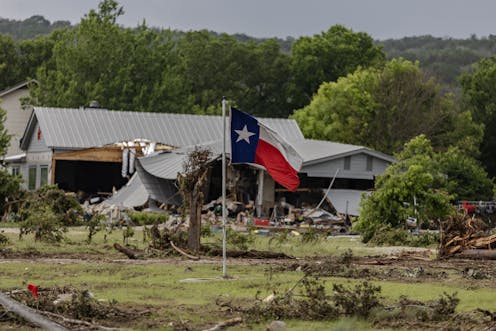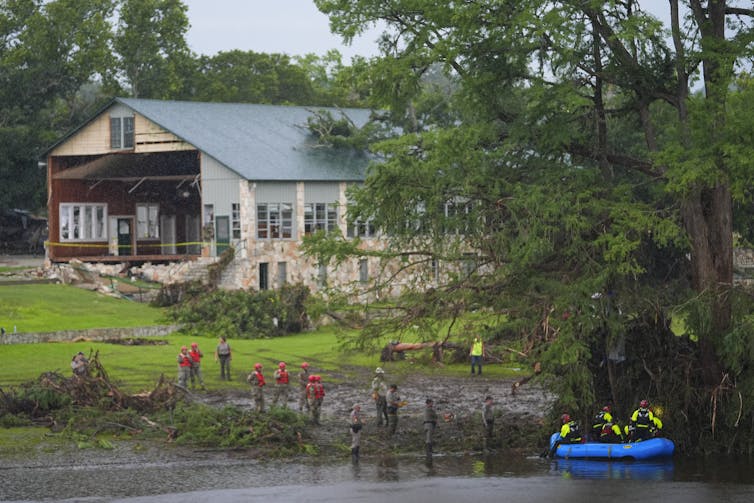Source: The Conversation – Canada – By Kristi Thompson, Research Data Management Librarian, Western University
The recent tragic floods in Texas have focused attention on the human impact of the cuts to government infrastructure and services in the United States by Donald Trump’s administration.
Although initial analyses suggest that recent budget cuts and loss of staff played no role in the timeliness of the warnings, many are concerned that a lack of data used to make critical predictions and decisions will increasingly become apparent as a serious problem.
As researchers focused on data management (Kristi) and behavioural sciences (Albert) and whose work tackles the significance of research with open access data, we have been concerned about how the data sets that scholars around the world rely on have been vanishing from U.S. government sites.
Vanishing data is of dire concern far beyond the U.S., including for Canadians.
Danielle Goldfarb, an expert on trade, real-time data, economics and public policy, notes that cuts to the National Oceanic and Atmospheric Administration’s Arctic monitoring programs weaken Canada’s ability to assess shared climate risks and global shipping impacts. The American dismantling of key weather reporting also threatens the availability of crucial data for Canada’s disaster preparedness.
The Canadian data community is watching U.S. events closely, and this has led to the recent founding of the Canadian Data Rescue Project. The project has a dual focus: to support data rescue efforts in the U.S. and to set up preventative life support for Canadian government data.
Attack on knowledge
The attack on knowledge in the U.S. began in January 2025 when Trump signed executive orders mandating the removal of information on topics such as diversity and “gender ideology” from government websites.
Next, entire websites, data distribution systems and data collection systems began to disappear. The result was not only growing alarm over how the needs of marginalized populations are represented in democratic life and how public safety could be affected, but also concerns about a research and public policy crisis.
Environmental data was a major target, with climate change tracking tools disappearing.
And as part of the defunding of the Department of Education, nearly all of the staff, including the commissioner at the National Center for Education Statistics, were fired.
Fundamental records
Government data provides the most fundamental record of how a society works. Health, social, economic and education data collections show a clear picture of how people live, and allow researchers to track how public policy changes affect everyday lives.
Government data is a unique resource because governments can require and enforce the collection of accurate information. This data also provides records of the activities of elected governments.
Eliminating data collection breaks the system of knowledge that allows governments to work well, and lets the public transparently see how they are working well.
Accuracy of data affects how people live
Data and budget cuts are already undermining economic policy in the U.S.
Inflation is a key indicator of economic health, and was an important electoral issue for Americans, with egg prices and other indicators coming up repeatedly in election campaigns.
But the Bureau of Labor Statistics, responsible for monitoring price changes, has been forced by staffing shortages to rely on less accurate data-collection methods. Now, according to the Wall Street Journal, economists are questioning the accuracy of the government’s inflation data.
Similar budget pressures hit climate science. The National Oceanic and Atmospheric Administration decommissioned its Billion-Dollar Weather and Climate Disasters Database as of May 8.
Read more:
Three scientists speak about what it’s like to have research funding cut by the Trump administration
This data tracked weather disasters where damages or costs reached or exceeded $1 billion and helped local and state governments plan, allocate budgets and advocate for funding. Employment losses are also expected.
Internationally, shuttering the U.S. Agency for International Development has led to data losses that will severely hinder global development goals. The Demographic and Health Surveys program helped governments of many low- and middle-income countries collect health and service data.
Losing aid funding will harm people directly. Losing the data will worsen that harm by preventing governments from making informed decision on allocating scarce resources, and it will hide how much harm is being done.
Limiting what can be known
Data destruction is a way to disrupt and control discourse by limiting what can be known. Without data, questions like “What impact are climate-related disasters having?” or “What’s the inflation rate?” are unanswerable. It becomes harder to effectively critique government actions.
If data destruction is an act of political suppression, then data preservation can be an act of political resistance.
In February 2025, several U.S. academic and non-profit associations got together to form the Data Rescue Project. They have worked to download data files, create documentation and prepare the data for publication on donated platforms.
While researchers are unable to change the termination of data collection programs, they are preserving as much data as possible so researchers and critics can at least access information.
The Canadian Data Rescue Project has hosted three data rescue events to create documentation for rescued American data sets, and is setting up processes to download and archive Canadian government data as a safeguarding measure.
Canadian data concerns
Disappearing data could happen here, and similar events have. Stephen Harper’s Conservative government cut data collection programs and issued gag orders to federal scientists.
The federal government reduced funding for environmental data collection and eliminated the First Nations Statistical Institute.
Researcher Melonie Fullick noted in 2012 that since 2009, “research on post-secondary education in Canada has been undermined by a systematic elimination of resources.” With the termination of varied education bodies or councils also came a scarcity of data.
The Harper government also eliminated the 2011 long-form census, replacing it with a voluntary survey, leading to the resignation of Canada’s national statistician and disrupting the baseline for all social and health data collection in Canada over the next few years.
Subsequent governments restored the census and some other data-collection programs, but in the case of education, researchers say some of the pains now being felt in the sector can be traced back to this period.
Canada at crossroads
A society knows itself through data, and makes a declaration about what it values by what it chooses to count.
Canada is now at a crossroads. Our researchers and policy analysts have piggybacked on U.S. data collection in critical areas from health to climate and weather forecasting. We now need a national response to help mitigate the effects of data destruction.
![]()
The authors do not work for, consult, own shares in or receive funding from any company or organisation that would benefit from this article, and have disclosed no relevant affiliations beyond their academic appointment.
– ref. Vanishing data in the U.S. undermines good public policy, with global implications – https://theconversation.com/vanishing-data-in-the-u-s-undermines-good-public-policy-with-global-implications-258230





